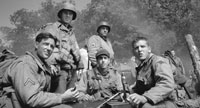Helmet Markings
Use of insignia and rank on helmets was quite varied and inconsistent during World War II. The task of applying such markings was usually given to soldiers with the most artistic talent, or simply given to low-ranking privates.
Medics
Most medics did not initially paint the Red Cross symbol on their helmets, but added it later once they realized that they would not (for the most part) be targeted by the Germans.
Officer/NCO Markings
All units participating in D-Day used a simple system of white bars to identify officers and non-commissioned officers. Officers wore a white vertical bar on the backs of their helmets, and non-commissioned officers wore a white horizontal bar. (The exact position of this bar often varied from soldier to soldier).
Some officers painted their rank insignia on the front of their helmets, while others removed most or all traces of their rank from their uniforms to avoid sniper fire.
Fact vs. Fiction
One of the most common criticisms leveled at Saving Private Ryan is the presence of a clearly visible painted rank insignia on Captain Miller's helmet. Rank insignia were often omitted from helmets in combat situations in order to prevent enemy forces from singling out and killing officers. Photographic evidence, however, clearly shows Ranger officers wearing white, painted rank insignia on their helmets during D-Day operations. Other evidence suggests that some officers may have painted their rank insignia with black paint in order to afford themselves some level of camouflage. (Captain Hamill's helmet has a black painted rank insignia). Either way, the presence of rank on Miller's helmet is not an error, and it helps remind the movie audience of Miller's status.
29th Infantry Division
All 29th Infantry Division soldiers were required to paint their division insignia on the front of their helmets.
2nd and 5th Ranger Battalions
Rangers of the 2nd and 5th Battalions painted an orange diamond on the backs of their helmets. Within this diamond was a black numeral indicating their battalion. The white bar marking officers and NCOs was sometimes painted below the diamond, and at other times was painted either in front of or behind the diamond (the number designating the battalion was always on top).
101st Airborne Division
The parachute infantry regiments of the 101st Airborne Division marked the sides of their helmets with distinctive symbols from playing cards. The 501st PIR used a diamond, the 502nd PIR a heart, the 506th PIR a spade, and the 327th GIR a club.
Most regiments used a system of small dashes around their regimental helmet insignia designed to indicate which battalion a solider belonged to. Headquarters was marked at the 12 o'clock position, 1st Battalion at the 3 o'clock position, 2nd Battalion at the 6 o'clock position, and 3rd Battalion at the 9 o'clock position.
On D-Day itself the 506th's 3rd Battalion had their helmets incorrectly marked with the dash representing the 1st Battalion. Outside of the parachute and glider infantry, the 101st Airborne utilized other combinations of symbols and dashes to identify unit affiliations.
The use of helmet netting in the 101st was not consistent, although those paratroopers that did wear netting for D-Day wore a large mesh net.
| Regiment | Unit | Unit | Unit | Unit | Preview |
|---|---|---|---|---|---|
| 501st PIR | HQ | 1st Btn | 2nd Btn | 3rd Btn |  |
| 502nd PIR | HQ | 1st Btn | 2nd Btn | 3rd Btn | |
| 506th PIR | HQ | 1st Btn | 2nd Btn | 3rd Btn | |
| 327th GIR | HQ | 1st Btn | 2nd Btn | 3rd Btn |
Fact vs. Fiction
Although the helmets for the 101st Airborne paratroopers in Saving Private Ryan do feature the proper regimental insignia, none of them show the proper battalion markings. (This would be corrected in Spielberg's Band of Brothers miniseries, which featured the 101st Airborne Division).
7th Navy Beach Battalion
All Navy units that would be operating on the beaches during D-Day were instructed to paint a thick gray band around their helmets so that they could be identified as Navy personnel, and not Army personnel. This band sometimes obscured insignia that were previously painted on the helmets.
Fact vs. Fiction
The 7th Navy Beach Battalion soldiers seen in the film have the correct gray band marking on their helmets, but the band does not cover the insignia on the front of the helmet as it would have in reality. The 7th NBB markings (the orange-red numeral 7 below an arc) would have been applied before there was knowledge that the gray band would be required at a later point in time.

